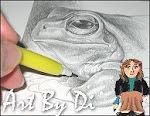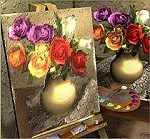Click image to enlarge
A new artwork, titled "Easter Cross" by Australian contemporary artist Di Mathews ( aka Diavma ). It is available for sale as an print on11x16inch high quality artist paper. Email diavma@gmail.com for more details.
It is said that the timeless nature of our spirit, the eternity of life, nature, and love, can be symbolised with a knot, which cannot see a beginning or an end. Always having enjoyed the intricacy of Celtic knots I thought this was the perfect way to represent the Easter Cross.
Once the initial design of the knot was mapped out the weaving of the imaginary threads, under and over one another, took on an almost meditative quality. By simultaneously participating in a few relaxed hours of silent prayer as I ran my electronic pen around the design shading the progression of threads, I wove my silent prayers into the artwork.
There is a modern symbolic interpretation of the cross which I like. The vertical section represent the transcendent, spiritual realm (the Father) and a horizontal section represents the immanent, physical earthly existence (the Son). Intersecting slightly above center at the point of the heart, creating wholeness (Holy Spirit) as God was made man.
The initial sketch of the design was created with a harsh red line, which cut into the surface of the image as if wounds in living flesh. As the colour was applied over the sketch I allowed some of the initial red to remain as a reminder of the cruelty and suffering that we are capable of inflicting. The colour for the Season of Lent is purple. The colour of bruising and violence, purple can symbolise pain, suffering, mourning and penitence, anticipating the suffering of the crucifixion. Purple, however, is also the colour of royalty and dignity, and so anticipates the coming resurrection, celebrating Christ's sovereignty.
Rather than placing the crown of thorns around or over the cross I decided to actually weave it through so that it becomes inseparable. The soldiers used a crown as a symbol of royalty and turned it into something painful and degrading by using thorns. This strengthened an already existing symbol of our sin dating back to Adam and Eve “…cursed is the ground because of you; in pain you shall eat of it all the days of your life; thorns and thistles it shall bring forth for you…” Intended to be a mockery, they gave the Lord the uniform of a sinner and the crown of thorn became a new symbol of Jesus’ sacrifice and accomplishment, having been delivered from the curse of sin.
Lilies are symbolic of joy, hope, beauty and life. Easter lilies are referred to as the “white-robed apostles of hope,” and indicate purity and innocence. According to myth, they were found growing in the Garden of Gethsemane, having sprung up where drops of His sweat fell to the ground and in every place that He had walked, prayed, sat, or wept the night before His crucifixion. I used three lilies at the base of the cross signifying the Trinity, and the virtues of faith in the Father, hope in the Son, and charity of the Holy Spirit.
The Easter Cross is the ultimate symbol of God's power and our salvation, indicative of the triumph of good over evil and life over death, through Christ’s crucifixion and resurrection. Like the knot, it symbolises eternal existence and love, without a beginning or an end.
Happy Easter.
20.3.12
Subscribe to:
Posts (Atom)











